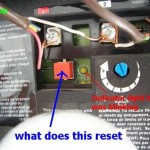How To Get Oil Out Of Concrete Garage Floor
Oil stains on a concrete garage floor are a common problem for many homeowners. Oil drips from vehicles, spills during maintenance, and general wear and tear can lead to unsightly and potentially damaging stains. Concrete is porous, which allows oil to penetrate and set, making removal a challenge. However, with the right tools, materials, and techniques, it is possible to effectively remove or significantly reduce the appearance of oil stains from concrete garage floors.
Addressing oil stains promptly is crucial. Fresh spills are much easier to clean than those that have been allowed to sit and penetrate the concrete for extended periods. The longer the oil remains, the deeper it seeps into the pores, requiring more aggressive and time-consuming cleaning methods. Furthermore, untreated oil stains can attract dirt and grime, further discoloring the concrete and creating a more significant problem.
Before commencing any cleaning process, it is essential to identify the type and age of the stain. This information will inform the choice of cleaning agents and methods. Fresh, light stains might respond well to simple absorption techniques, whereas older, more deeply embedded stains may require chemical solvents or specialized concrete cleaners. Additionally, understanding the type of oil involved (e.g., motor oil, transmission fluid) can help determine the most effective cleaning solution.
Safety is paramount when dealing with oil stains and cleaning agents. Always wear appropriate personal protective equipment (PPE), including gloves, eye protection, and, if necessary, a respirator. Work in a well-ventilated area to avoid inhaling fumes from cleaning products. Carefully read and follow the manufacturer's instructions for all cleaning products, and never mix different chemicals, as this can create hazardous reactions.
Key Point 1: Immediate Action and Absorption
The first line of defense against oil stains is immediate absorption. When an oil spill occurs, the goal is to prevent the oil from seeping into the concrete pores as quickly as possible. Numerous absorbent materials are readily available and effective in this regard. The choice of absorbent material often depends on what is readily available and the size of the spill.
One of the most common and readily available absorbent materials is kitty litter. Clay-based kitty litter, specifically, is highly effective due to its porous nature, which allows it to draw oil out of the concrete. To use kitty litter, simply pour a generous amount onto the fresh oil spill, ensuring that the entire stain is covered. Allow the kitty litter to sit for several hours, or preferably overnight, giving it ample time to absorb the oil. After the absorption period, sweep up the kitty litter and dispose of it properly according to local regulations regarding hazardous waste (as it will now contain oil). Afterwards, proceed to other cleaning methods to remove residue and any remaining stain.
Other effective absorbent materials include sawdust, corn starch, and baking soda. These materials function similarly to kitty litter, absorbing the oil through their porous structure. Sawdust is particularly useful for larger spills, while corn starch and baking soda may be better suited for smaller, more contained stains. The application process is the same: cover the stain generously with the chosen absorbent material, allow it to sit for several hours, and then sweep it up and dispose of it appropriately.
For more significant spills, or in professional settings, commercial oil absorbents are available. These absorbents are often made from specialized materials that are highly efficient at absorbing oil. They may come in various forms, such as powders, granules, or pads. The manufacturer's instructions should be followed carefully when using these products.
After removing the bulk of the oil with an absorbent material, a residue will often remain on the concrete surface. This residue needs to be addressed to prevent it from setting into a more permanent stain. A simple solution of dish soap and water can be used to scrub the area. Apply the soapy water to the stain, scrub vigorously with a stiff-bristled brush, and then rinse thoroughly with clean water. This will help to lift any remaining oil residue from the concrete surface.
Key Point 2: Chemical Cleaners and Degreasers
When absorbent materials are not sufficient to remove the entire stain, or when dealing with older, more stubborn stains, chemical cleaners and degreasers may be necessary. A variety of chemical products are specifically formulated to break down and lift oil stains from concrete. The choice of cleaner will depend on the severity of the stain and the type of oil involved. It is crucial to use these products with caution and follow the manufacturer's instructions carefully.
One common type of chemical cleaner is a concrete degreaser. These degreasers typically contain solvents or enzymes that dissolve the oil, making it easier to remove. When using a concrete degreaser, apply it to the stain according to the manufacturer's instructions. Generally, this involves pouring the degreaser onto the stain and allowing it to sit for a specified period, typically 15-30 minutes, to allow the chemicals to penetrate the concrete and break down the oil. After the dwell time, scrub the area vigorously with a stiff-bristled brush and rinse thoroughly with clean water. Multiple applications may be necessary for heavily stained areas.
Another option is to use a concrete cleaner specifically designed for oil stains. These cleaners often contain a blend of detergents, solvents, and enzymes that work together to remove the oil. Similar to degreasers, these cleaners are applied to the stain, allowed to dwell, scrubbed, and rinsed. It is essential to choose a cleaner that is compatible with concrete and will not damage the surface.
For particularly stubborn stains, a poultice method may be effective. A poultice is a paste-like mixture that is applied to the stain and allowed to dry, drawing the oil out of the concrete as it dries. A common poultice mixture consists of a solvent (such as acetone or mineral spirits) mixed with an absorbent material (such as diatomaceous earth or baking soda) to form a thick paste. The poultice is applied to the stain, covered with plastic wrap to prevent rapid evaporation, and allowed to dry completely, typically for 24-48 hours. Once dry, the poultice is scraped off, taking the absorbed oil with it. The area should then be rinsed thoroughly with clean water.
When using any chemical cleaner, it is crucial to test it in an inconspicuous area first to ensure that it does not discolor or damage the concrete. Some cleaners may be too harsh for certain types of concrete, potentially causing etching or discoloration. Always wear appropriate PPE, including gloves and eye protection, and work in a well-ventilated area to avoid inhaling fumes.
Key Point 3: Advanced Cleaning Techniques
In cases where absorbent materials and chemical cleaners are insufficient to remove deeply embedded oil stains, more advanced cleaning techniques may be necessary. These techniques often involve specialized equipment or more aggressive cleaning methods. It is advisable to consider these options when dealing with persistent or very old stains.
One such technique is pressure washing. A pressure washer uses a high-pressure stream of water to blast away dirt, grime, and oil stains from concrete surfaces. While pressure washing can be effective, it is crucial to use the correct pressure setting and nozzle to avoid damaging the concrete. A wide-angle nozzle and a lower pressure setting are generally recommended to prevent etching or pitting of the concrete surface. It is also essential to wear appropriate PPE, including eye protection, as the high-pressure water can propel debris.
For particularly stubborn stains, a hot water pressure washer may be more effective. The heat helps to loosen the oil and emulsify it, making it easier to remove with the high-pressure water. However, hot water pressure washers require specialized equipment and safety precautions, as the water can reach scalding temperatures.
Another advanced cleaning technique is grinding or polishing the concrete surface. This involves using a concrete grinder or polisher with abrasive pads to remove the top layer of concrete, including the oil stain. Grinding or polishing can be an effective way to completely eliminate the stain, but it also changes the appearance of the concrete and may require additional finishing steps to restore a uniform look. This method is best left to professionals who have experience with concrete grinding and polishing.
In some instances, steam cleaning can be effective. Steam cleaners use high-temperature steam to loosen and lift oil stains from concrete surfaces. The steam penetrates the pores of the concrete, dislodging the oil and allowing it to be wiped away. Steam cleaning is a relatively gentle method that is less likely to damage the concrete compared to pressure washing or grinding. However, it may not be effective for deeply embedded or very old stains.
Ultimately, the success of these advanced cleaning techniques depends on the severity of the stain, the type of oil involved, and the condition of the concrete. It is often advisable to consult with a professional concrete cleaner or contractor to assess the situation and determine the most appropriate cleaning method. They can provide expert advice and ensure that the cleaning process is carried out safely and effectively.
Regardless of the cleaning method chosen, proper disposal of used cleaning materials and contaminated oil is essential. Oil and oil-soaked materials should not be disposed of in regular trash or poured down drains, as this can contaminate the environment. Instead, contact a local waste management facility or environmental agency to inquire about proper disposal methods. Many communities offer hazardous waste collection programs for disposing of oil and other potentially harmful materials.

Tips To Remove Oil Stains On Your Garage Floor

How To Remove Oil Stains From Driveway In 5 Steps Prosoco

How To Remove An Oil Stain From Concrete

How To Clean Oil Off Concrete Garage Floor Spillfix

How To Get Stains Out Of Your Concrete Garage Floor Ohio Interiors

How To Clean Concrete Garage Floors From Oil Stains Rust

How To Remove Old Oil Stains From Garage Floor Flow Wall

How To Clean A Oil Stain Garage Floor

How To Remove Oil Stains From Concrete Floors Family Handyman

Removing Oil Stains In A Concrete Floor
Related Posts








